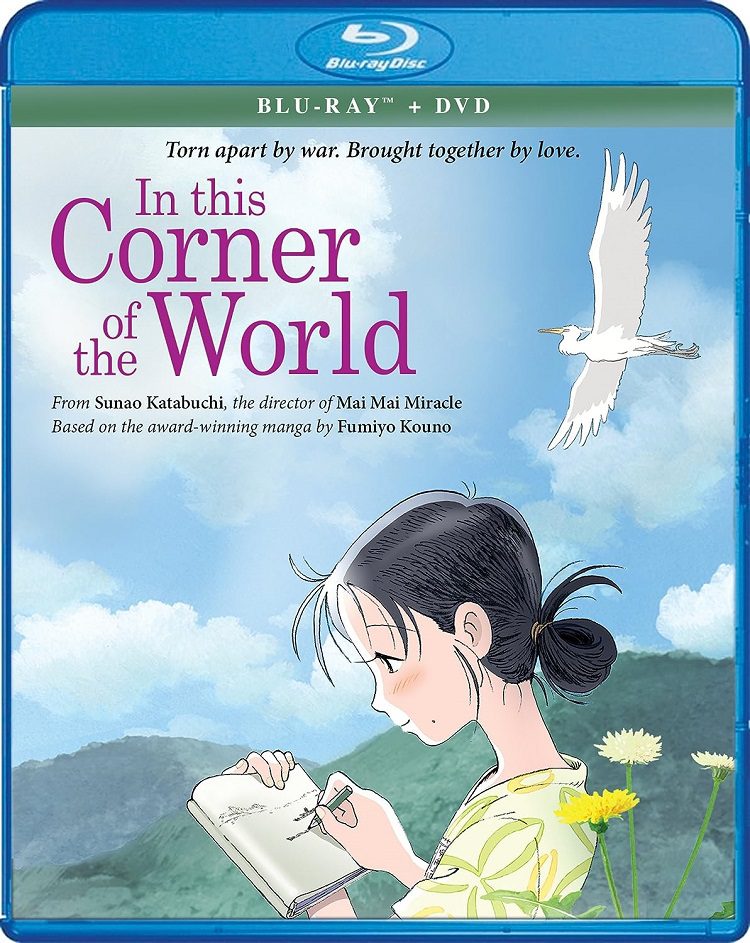
In This Corner of the World is a Japanese animated movie that tells the wartime story of Suzu, a sweet but ditsy young girl who at 18 is shipped from her home in Hiroshima to be married to Shusaku, a young man from Kure, a port and shipbuilding city about 15 miles away. It’s 1944, and the war is beginning to come home to Japan in earnest. Shusaku’s mother is in ill health, and the family needs a new girl to help take care of the home. Maybe the couple will love each other some day, and her new family is mostly kind, but Suzu is primarily wanted for labor.
Which does not suit her character at all, since she’s an inveterate daydreamer who follows her whims without much of a thought for where they might take her. She likes to make up stories for her younger sister, and is drawing constantly. Still, she’s conscientious, and does her level best to make her new home run right. She does so under the watchful eye of Shusaku’s sister, Keiko, who has come back home with her young daughter Harumi after the death of her husband. Keiko dislikes Suzu from the start, but Harumi is immediately attached to her, since they have about the same mentality: Suzu, despite the hard work and learning she puts into keeping the family together, is rather child-like in her approach to life.
This immaturity is reflected in the character designs, which take the tendency of anime characters to have child-like proportions to near extremes. Every face is rounded and over-large in proportion to the bodies, as are their hands. It is an interesting choice. It might be intentional to reflect the inherent innocence of one family being foisted into the horrors of war through no choice of their own, or it might just be the way Suzu sees life. The contrast of these child’s bodies and the terrible violence they are eventually put to as the end of the war draws nearer does make a disturbing contrast.
Suano Katabuchi directed and wrote the film (based on a manga) and as is typical of his feature films he employs multiple styles of animation. Most of the film is depicted in typical anime limited animation (where characters and various parts of the screen will move against static backgrounds) but occasionally it evokes Suzu’s pencil drawings, and one striking sequence is animated in white charcoal on black backgrounds. In This Corner of the World‘s color scheme tips toward pastel and water colors, adding to the nostalgic feeling of the picture. Like his other features, Princess Arete and Mai Mai Miracle, Katabuchi is concerned with comparing the fantasy lives of his female protagonists with the real world that inevitably comes crashing in around them. In this film, the crash is literal, as the shipyards of Kure are bombed while Suzu is taking Harumi for a walk.
There have been several anime movies about life in Japan during WWII, most famously the Ghibli production of Grave of the Fireflies. That film was dedicated to grim and bleak realism, and while In This Corner of the World doesn’t shy from the horrors of war and contains some heart-breaking developments, but it doesn’t approach the tone of despair that Fireflies does. Partly that’s due to the childishness of the protagonist. Suzu never really grows up through most of the film, which is often endearing but it also means there’s a certain element of distance between her and the audience. She gets embarrassed by attention like a small child, and when she makes decisions, even life-altering ones, she rarely explains her positions, but remains sullenly silent. That’s pretty typical for characters in anime, and in this movie it is typically infuriating, since it doesn’t really scan with the character. Suzu is shown constantly working hard to keep the family fed despite the tightening of the rationing belt and the worsening of conditions around her. It seems like it should be part of a character arc of a girl finding maturity in womanhood, but it doesn’t seem to affect her at all.
Defects in some characters aside, In This Corner of the World is an illuminating, and heart-touching depiction of a family stuck in wartime. It is striking how hard and for how long Suzu has to work to just keep the family in the most basic level of care – with clean clothes and fresh food three times a day, while the man were away at work all day. Maintaining continuity of existence, however war may make it impossible, is the film’s central theme. What would have elevated the movie beyond the illuminating is if its central character went on the same journey of understanding as the audience.
In This Corner of the World opens in New York, Los Angeles and San Francisco this Friday, August 11. On August 18, this movie is expanding to more screens in Los Angeles, SF Bay Area and is set to open in major cities in the U.S. and Canada.
Suano Katabuchi on animating the film: